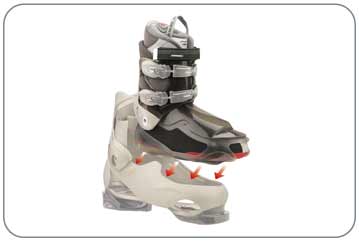
| New Ski Boots for 02/03
Downside: Will the soft boot last?
McLEAN, Va.
(Winter 2002-03) -- Ski boots have grown more inviting, skis more versatile
and bindings safer. And "systems" — matched suites of boot, ski
and binding — are now available for all skill levels.
That’s the news from the ski equipment makers, according to SnowSports Industries America (SIA), the national, not-for-profit trade association that represents ski, snowboard and other winter sport-oriented companies. In a highly competitive market, wintersport factories are scrambling to make buying decisions easier. One way is with ski-binding and ski-boot-binding systems, built to be sold together, rather like matched stereo components. Major brands like Atomic, Head/Tyrolia, Nordica, Rossignol, Salomon and Volkl/Marker, have engineered entire suites of equipment to match in the ski shop and on the slopes. Find a boot that fits and flexes comfortably, and the matching ski and boot will work perfectly with it. That, at least, is the plan. But the growing popularity of systems shouldn’t obscure the fact that individual product categories have been improving on their own trajectories. For instance, boot designers have literally opened new doors for easy entry and fit. Boots: Easier Fit During the fall of 2001, skiers got their first look at an all-new ski boot concept: the soft boot. In effect, the soft boot cuts the top off the ski boot’s stiff plastic shell, turning it into a convertible. Closure uses a couple of buckle straps closing over a comfortable "rag top." The concept was promoted by Rossignol, Salomon and Kneissl, and it was accepted almost instantly by casual or "leisure" skiers. At least five more ski boot manufacturers have introduced easy-to-enter boots for winter 2002-03. Easy entry has always been a serious issue for boot makers, because those leisure skiers — who comprise the bulk of their market — often complain of discomfort while trying to squeeze a foot past the stiff flaps of a performance ski boot. In the past, boot designers have resorted to rear-entry and mid-entry designs to make boot entry easier and more comfortable. Rear-entry boots are opened and closed in the back with a single buckle. They are used for beginners and young children, because they don’t have the necessary support for more advanced skiers. Mid-entry boots incorporate both rear-entry and overlap (i.e. front buckle closure) technology. They use a combination of buckles in the back and front and are designed to be easy to get in and out of, but sometimes lack the high-performance of traditional overlap boots. But those designs compromised boot performance. They required a looser fit, impairing a skier’s ability to control the skis with accuracy and power. The new easy-on designs follow two main design paths: soft boots and traditional stiff high-performance shells with special hinged panels to open the overlap flaps wide. Boot Highlights for Winter 2002-03 Atomic: Atomic’s new Soft Tech boots look conventional, but use soft plastic flaps over theinstep and a very soft, textile-backed plastic in the cuff — all for easy entry and exit. Kneissl: Kneissl’s original soft boot, the Rail 22, used a whippy steel rod along the sides of the shell to control boot flex, and it was aimed at advanced intermediate skiers. For next season, Kneissl introduces three additional Rail models for the full range of skier abilities: the Scandium is for experts, the Titanium for intermediate skiers and the Chrome is for newcomers to the sport. Rossignol: Rossignol made a huge splash last fall with its Soft 1 and Soft 2 boots, aimed at intermediate and beginner skiers. The Soft boots closed with very flexible leather-like flaps and were created with a focus on comfort for the instep and shin — traditional sore points for new skiers. For next year, the Soft 1 and Soft 2 are a bit stiffer in flex to meet the needs of more advanced skiers, and the series expands with the addition of the less expensive Soft 3. All three models now use a rubber sole for walking security. Salomon: Salomon’s entry into the soft boot category was the Verse, designed to close with a single pull on a slick speed-lace system — a technology adapted from the company’s very successful line of hiking and cross-country ski boots. For next year, the Verse line expands with the addition of the Verse CF (for Custom Fit) — it uses a heat-moldable liner for an accurate, comfortable fit. Dalbello: Dalbello introduces three easy-on systems. The Vision Lite is a soft boot aimed at casual skiers, who typically want a cushy, comfy, walking-shoe fit. For better skiers, who want a more precise fit, the Auto Instep system introduces a set of soft plastic flaps over the instep. With the buckles open, the skier can slip a foot between these soft flaps, hands free. It’s found on the new NX-series models. Dalbello has also modified its high-performance V-series boots, aimed at experts and advanced skiers, with a new Ergo Entry system: the overlap flaps over the instep are built with soft-flexing gussets so the foot can enter and exit without pinching. Dolomite: Dolomite’s new Venture boots feature an "active entry" shell design — the instep opening extends all the way to the toe (most boots split only as far as the ball of the foot). The extended flaps open wide for easy step-in. Another new group from Dolomite is the Comfort Concept series, which uses an open-throat shell design. The shell is sealed by an external tongue that hinges forward for entry. Head: Head created its EZ-On series last year, aimed at beginners. Now there’s a group of firmer-flexing boots for intermediate skiers: The Extra Comfort Technology (ECT) boots are built with very soft plastic along the sides of the foot. To give the boot the needed structure to control the ski, a flexible plastic rib runs up the top of the foot to the shin. Nordica: Nordica’s new SmarTech boot is built on a super-rigid sole, with an arch-shaped aluminum brace attached to the heel to provide rearward support for the lower leg. The cuff is mounted to the brace — leaving the instep wrapped in a comfortable soft liner. To close and tighten the boot, just pull on a single handle mounted on the aluminum brace. Tecnica: Tecnica has built its reputation largely on high-performance and race boots. Tecnica designers didn’t want to compromise the flex and fit of their successful expert-level boots. So they simply built a mechanical hinge into the cuff flaps. The result: the Rapid Access system, with doors that open wide for pinch-free entry and exit. Lange: Lange has no intention of diluting its reputation for high performance racing boots. About 70 percent of World Cup races are won in Lange boots, and in this Olympic year the company put most of its development effort into a new line of lighter, stiffer Competition models, designed by the same Pininfarina studio responsible for Ferrari’s swoopy shapes. The unique RRS series of Rear Release System boots is designed to reduce the risk of knee injury. Lab tests by the Swiss TUV safety institute support Lange’s claim that the RRL system cuts the injury rate to the anterior cruciate ligament (ACL) by about 30 percent. The system is now available on three models. ***SIA*** SnowSports Industries America (SIA) is the national, not-for-profit, member-owned trade association that represents snow and winter sports outdoor companies. SIA produces the SIA SnowSports Show, the largest trade show and gathering place for the snow sports industry. Proceeds from the SnowSports Show fund market development programs for all snow sport disciplines. SIA also annually produces more than a dozen industry research studies. For more information, check out www.snowlink.com. SnowSports Industries America, 8377-B Greensboro Drive, McLean, VA 22102-3587. Phone: (703) 556-9020, Fax: (703) 821-8276, Email: siamail@snowsports.org. — Posted by Ari Cheren, MountainZone.com Gear Editor |

